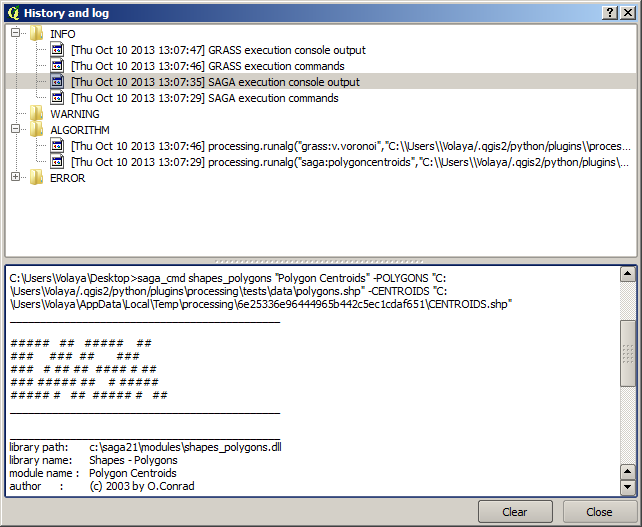The history manager¶
The processing history¶
Every time you execute an algorithm, information about the process is stored in the history manager. Along with the parameters used, the date and time of the execution are also saved.
This way, it is easy to track the and control all the work that has been developed using the processing framework, and easily reproduce it.
The history manager is a set of registry entries grouped according to their date of execution, making it easier to find information about an algorithm executed at any particular moment.
Figure Processing 30:
Informações sobre o processo são mantidas como uma expressão de linha de comando, mesmo se o algoritmo tiver sido iniciado a partir da caixa de ferramentas. Isso o torna útil também para aqueles que sabem como usar a interface de linha de comando, já que podem chamar um algoritmo usando a caixa de ferramentas e, em seguida, verificar o gerenciador de histórico para ver como é que o mesmo algoritmo pode ser chamado a partir da linha de comando.
Além de exibir as entradas no registro, os processos podem ser re-executado, simplesmente clicando duas vezes sobre a entrada correspondente.
Along with algorithm executions, the processing framework communicates with the user using the other groups of the registry, namely Errors, Warnings and Information. In case something is not working properly, having a look at the Errors might help you to see what is happening. If you get in contact with a developer to report a bug or error, the information in that group will be very useful for him to find out what is going wrong.
When executing third party algorithms, this is usually done calling their command-line interfaces, which communicate with the user using the console. Although that console is not shown, a full dump of it is stored in the Information group each time you run one of those algorithms. If, for instance, you are having problems executing a SAGA algorithm, look for an entry name ‘SAGA execution console output’ to check all the messages generated by SAGA and try to find out where the problem is.
Some algorithms, even if they can produce a result with the given input data, might add comments or additional information to Warning block in case they detect potential problems from that data, in order to warn you about them. Make sure you check those messages in case you are having unexpected results.

